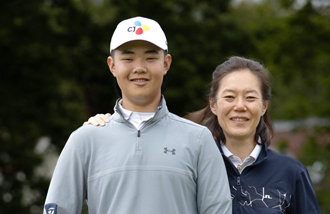Doctors should look for hospitals providing surgeries drives
Doctors should look for hospitals providing surgeries drives
Posted March. 31, 2023 08:09,
Updated March. 31, 2023 08:12



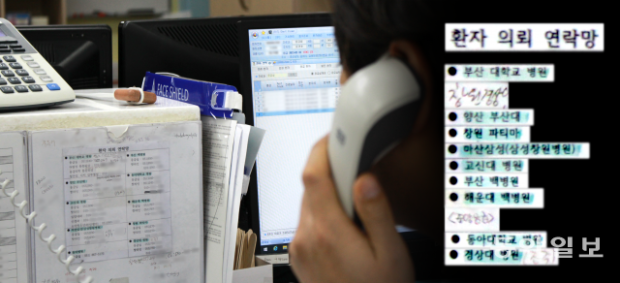
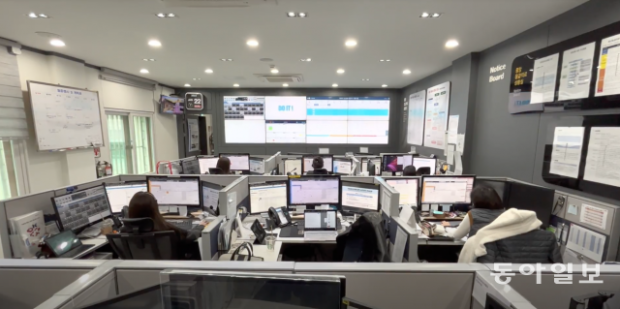

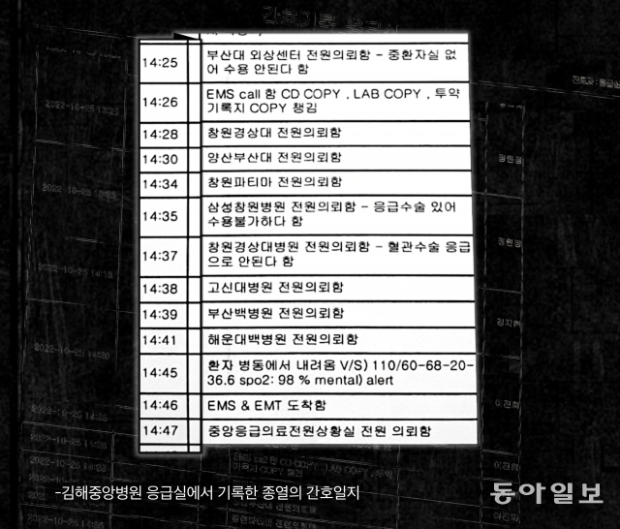
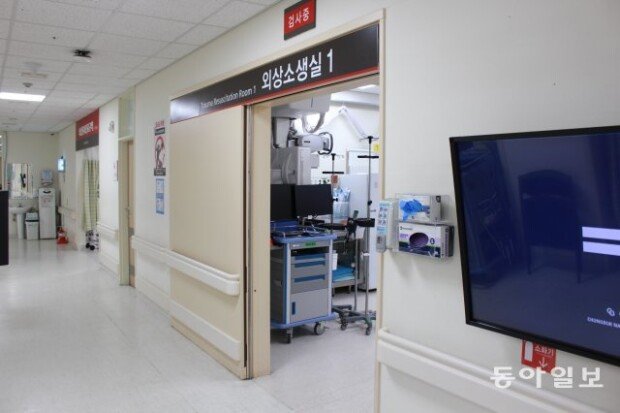


Even within one minute, which you may not even notice passing, emergency patients can stand at the crossroads of life and death. Undoubtedly, it must be one of the worst nightmares for their families who desperately pray for a miracle. It may feel as if the misery will last forever while they are overwhelmed by the fear of losing their beloved ones in the worst-case scenario.
The terrifying time of one minute occurred to Lee Jun-gyu, 13, and his mother, Yun-yeong, on Dec. 8 last year. Having no idea that a brain hemorrhage was killing her son’s brain cells, she had no option but to watch dispatchers calling eight ERs to ask to take in the bleeding boy.
On Oct. 25 last year, Park Jong-ryeol kept pleading for help. Even while he was suffering excruciating pain in his leg, as many as 23 medical centers rejected an operation to put the broken vessels together. The Dong-A Ilbo's Hero Content Team tracked down every minute of the 228 minutes and 378 minutes during which Jun-gyu and Jong-ryeol, respectively, were left untreated while something was going dreadfully awry among first-aid dispatchers, ERs, and operating rooms.
The team talked to 31 interviewees including dispatchers, which transported the two patients, and ER doctors and surgeons who treated them. To disclose what was unfolding while emergency patients, untreated, were left adrift, a thorough review was done of exclusive data, including the telephone call records provided by the 119 General Situation Room of the National Fire Agency and the disaster situation room of the National Emergency Medical Center.
The results were that the first-aid medical service system ridden with loopholes makes it inevitable for everyone involved to end up in a tragedy even after they all do their best. It turned out that the government-run situation dashboard for emergency cases did not serve the purpose of helping 119 dispatchers and ER doctors figure out where surgeons are available to perform an operation. The only way to report patients' health status was to call every single hospital. The double system of the 119 General Situation Room of the National Fire Agency and the disaster situation room of the National Emergency Medical Center, both short-staffed, failed at doing their jobs. What’s worse, there were a shockingly small number of surgeons on standby for surgery. Given the severity of the realities, it was lucky that Jun-gyu and Jong-ryeol could enter the operation room at the last minute.
Here’s an autopsy report of a reason for demolishing the healthcare safety nets in our society.
(Jong-ryeol’s 378 minutes)
At 10:09 a.m. on October 25, 2022, Park Jong-ryeol, aged 39, was crushed by a forklift at a factory in Gimhae City in South Gyeongnam Province and broke his left thigh bone. His colleague dialed 119.
Although it was unknown at the time, Jong-ryeol suffered a broken bone and a damaged vein. Jong-ryeol might have to amputate his leg unless he needs quick vein surgery.
Doctors say that endovascular surgery on the leg is a time-critical procedure and must be performed within eight hours of the injury.
Jong-ryeol was moved by an ambulance to Gimhae Central Hospital (currently Kyunghee Central Hospital). Dr. Yoon Gi-ho, who was in charge of the emergency room that day, examined Jong-ryeol’s leg. There was not much bleeding. The patient reported numbness in the leg, but it was a common symptom of broken bones.
Dr. Yoon moved Jong-ryeol to an orthopedic physician who said he would directly examine the patient. Patients with complicated symptoms continued to arrive at the emergency room: a man in his 60s with heart failure, a patient in his 80s with jaundice, and a 90-year-old who suddenly lost consciousness.
Dr. Yoon turned his attention to other patients. In the meantime, orthopedic physicians found during rounds that Jong-ryeol, who was hospitalized by that time, had not only broken bones but damaged veins—that the patient was in need of emergency surgery; otherwise, he might have to amputate the leg. The hospital could not provide such a surgery, and the patient had to be transferred to another hospital.
Jong-ryeol was moved back to the emergency room to be transferred to other hospital where the patient could receive a surgery.
Dr. Yoon received a call from the orthopedic department that the patient needed to be transferred to a hospital where it could provide an endovascular surgery. It was an ER doctor’s job to look for a hospital with a vascular surgeon who could perform a surgery. There are not enough doctors, even in university hospitals who can perform an endovascular surgery on the leg, which requires a high level of proficiency.
Dr. Yoon was not much worried, as most university hospital professors were on the job on weekday afternoons. He was sure that there would be at least one doctor who could perform a surgery on Jong-ryeol.
Indeed, one doctor could perform a surgery that Jong-ryeol needed at Chungbuk University Hospital in Cheongju City, North Chungcheong Province, which is 260 kilometers away: He was Dr. Yoo Kwon-cheol of the vascular department. He performed surgeries on seven patients a day before and stood on night duty. That day, he had already performed one surgery and was seeing outpatients. A doctor like Yoo has frequent emergent surgeries, faster forward rotating shifts, and no guaranteed day-off.
Dr. Yoo received a message from his wife that his seven-year-old child had a high fever. When he returned home late at night, Yoo’s son asked an innocent question: “Dad, how many surgeries did you do today?” The higher the number was, the prouder the child was of his father. The children were the reason Yoo could pull an all-nighter in the hospital every day.
Dr. Yoo was determined to go home after his outpatient appointments.
Five minutes after the decision of transfer, Dr. Yoon called Busan University Hospital’s regional trauma center, the nearest regional trauma center that was eventually responsible for patients with major trauma.
Dr. Yoon hailed a private ambulance that could take Jong-ryeol and ordered a nurse to prepare Jong-ryeol’s medical records to make sure not one minute is wasted when Busan University Hospital gave admission.
However, Busan University Hospital said it had no empty ICU bed and could not admit Jong-ryeol.
Dr. Kim Young-dae, chief of the regional trauma center of Busan University Hospital, rechecked the ICU board and sighed. There were four surgeons capable of performing vascular surgery, and one might be able to make time for the surgery. The problem was that there was no ICU capacity.
Busan University Hospital usually keeps at least five trauma ICU beds empty in the event of a mass casualty incident, which is the regional trauma center’s role to take care of. However, 29 hours ago, 42 ICU beds were all occupied and no bed was left for a new patient. Seven ICU beds were occupied by COVID-19 patients, which was the reason for the ICU bed crunch.
Sending a patient who got relatively better to other wards was impossible, as there was no patient whose condition improved to be discharged from the ICU.
There was no time to stay disappointed. Yoon pulled out his phone again.
At 2:28 p.m., Dr. Yoon dialed Gyeongsang University Hospital in Changwon City: “An emergency vascular surgery is impossible,” it said.
At 2:30 p.m., he dialed Yangsan Busan University Hospital: “Two surgeons are performing emergency surgeries,” it said. One doctor just began a lung transplant with organ donation from a brain-dead patient, and the other was operating on a child patient. Both surgeries had just begun, and it was unpredictable when the surgeries would end.
At 2:34 p.m., Dr. Yoon called Changwon Fatima Hospital: “Surgery is unavailable,” it said.
At 2:35 p.m., Dr. Yoon called Samsung Changwon Hospital: “Doctors in charge are in emergency surgery, and there is no ICU bed,” it said.
Although the information chart shared through the central emergency medical center showed that there were empty ICU beds in Samsung Changwon Hospital, they were reserved for two patients who were in emergency surgery at the time. A doctor who could operate vascular leg surgery was also in surgery. The doctor finished the surgery four hours later.
At 2:38 p.m., Dr. Yoon called Kosin University Gospel Hospital: “Surgery is unavailable,” it said.
At 2:39 p.m., Dr. Yoon dialed Inje University Seoul Paik Hospital: “Surgery is unavailable,” it said.
At 2:41 p.m., Dr. Yoon called Inje University Haeundae Paik Hospital: “There are no doctors who could operate with an ongoing orthopedic department’s academic conference,” it said.
Twenty-seven minutes passed since the decision of transfer was made. Dr. Yoon requested to look for a hospital in the Central Emergency Medical Situation Room. The situation room is a state-run organization that helps arrange hospitals when an emergency room patient needs to be transferred to hospitals in other cities and provinces. Although the government promoted that a number of concurrent requests can be made to different hospitals through the emergency room patient transfer network, Yoon had no idea about the existence of such a system.
At 2:52 p.m., Dr. Yoon called Dong-A University Hospital: “We have admitted a similar patient, so we cannot admit your patient,” it said.
At 2:53 p.m., the situation room contacted the regional trauma center of Busan University Hospital, where Dr. Yoon had called earlier. The situation room called there again to see if there had been a change in the circumstance. Furthermore, sometimes hospitals were more cooperative when the situation room made a request. However, there were still no empty ICU beds.
At 2:53 p.m., the situation room called Jinju Gyeongsang University Hospital: “A medical staff in charge is currently treating other patients. We will call you later,” it said. Approximately 40 minutes later, the hospital said that it had no available medical staff.
At 2:56 p.m., the situation room called the regional trauma center of Ulsan University Hospital: “Call an emergency department,” it said.
At 2:58 p.m., the situation room called the emergency department of Ulsan University Hospital: “A medical staff in charge is currently absent, so we cannot admit your patient,” it said.
At 3:00 p.m., Yoon dialed Gyeongbuk University Hospital: “We cannot admit your patient,” it said.
At 3:00 p.m., Dr. Yoon contacted Ulsan Dongkang Medical Center: “We cannot admit your patient,” it said.
At 3:00 p.m., the situation room called Hanyang University Changwon Hanmaeum Hospital: “We will see and call you back,” it said.
At 3:04 p.m., Changwon Hanmaeum Hospital called back the situation room: “Surgeries are all booked,” it said.
At 3:07 p.m., Dr. Yoon called Jinju Gyeongsang University Hospital: “We’re in shortage of medical staff, so we cannot admit your patient,” it said. Although two doctors could perform a vascular leg surgery, one was operating on a patient, and the other was on a business trip to set medical license exam questions.
At 3:08 p.m., the situation room called the regional trauma center of Gyeongbuk University Hospital: “We are in short of ICU beds,” it said.
At 3:09 p.m., the situation room contacted Daegu Fatima Hospital: “We will check,” it said.
At 3:12 p.m., Dr. Yoon called Youngnam University Hospital: “We have many patients awaiting surgery, so we cannot admit your patient,” it said.
At 3:18 p.m., the situation room contacted Keimyung University Dongsan Hospital: “Medical treatment for vascular diseases is unavailable,” it said.
At 3:19 p.m., the situation room contacted Busan Micro Hospital: “No ICU beds are available,” it said.
At 3:22 p.m., Yoon called the regional trauma center of Andong Hospital: “We cannot admit your patient,” it said.
No surgeon can operate on leg blood vessels at the Regional Trauma Center of Andong Hospital. Director Kim Hyo-yoon has been posting surgeon recruitment notices to a doctor community for several years, but it has been a futile attempt so far. Even two or three years ago, although rare, some people showed interest in such postings, followed by sending a recruiter anywhere in the country who almost begged them to work at the center. But these days, there is not even a call that comes in to show such interest.
Dr. Yoon didn't express it explicitly because he didn't want to get Jong-ryeol rattled, but he was quite taken aback internally. He didn't expect to see such a serious shortage of surgeons as it was a weekday afternoon.
The face of an acquaintance overlapped over Jong-ryeol's face, which was in pain. My acquaintance needed brain surgery as his condition suddenly deteriorated while hospitalized last year. Dr. Yoon contacted doctors he knew and asked them to find a hospital that could operate, but it was to no avail, and his acquaintance eventually passed away.
In order not to relive the tragedy and save Jong-ryeol's legs, he couldn't stop calling.
At 3:23 p.m., Dr. Yoon called Changwon Hanmaeum Hospital, but the hospital said, “It is impossible to take the patient.”
At 3:25 p.m., the situation room called the Regional Trauma Center of Andong Hospital, but it said, “There are no vascular surgeons.” It had no choice but to give the same answer as when Dr. Yoon called.
At 3:26 p.m., the situation room called Yeungnam University Hospital. The hospital said, “It is difficult to accept other patients because we have to handle many orthopedic surgeries.”
At 3:28 p.m., Dr. Yoon called Pohang Semyung Christian Hospital. The hospital said, “vascular surgery is not available.”
Seventy minutes after the transfer decision, Dr. Yoon received a call from the situation room. “All hospitals in Gyeongnam and Gyeongbuk area cannot accept the patient.” This meant that no single hospital could have surgery in this vast North Gyeongsang region.
When even the situation room couldn't find the hospital, Dr. Yoon had no choice but to activate the “private network.” He posted what Jong-ryeol was going through in a group kakaotalk room where his former resident classmates gathered. However, he only got, “My hospital cannot admit the patient either.” As a last-ditch effort, Dr. Yoon called Miok, Jong-ryeol's wife, and said, "If there are any doctors you know, contact them and ask them to accept the patient."
At 3:36 p.m., the situation room called the Regional Trauma Center at Chonnam National University Hospital. The hospital said, “Please call the emergency room.”
At 3:39 p.m., the situation room called the Regional Trauma Center of Wonkwang University Hospital. The hospital said, “Related surgery is impossible.” Initially, this hospital had one surgeon who could operate on leg blood vessels, but that doctor left the hospital two years ago.
At 3:41 p.m., a call came from Daegu Fatima Hospital to the situation room. The hospital said earlier that they would check whether the surgery was possible and contact me. However, the answer from the hospital was, of course, “surgery is impossible; there is no doctor.”
At 3:44 p.m., Dr. Yoon called Dankook University Hospital. The hospital said, “There are no vacancies in the intensive care unit.” In the intensive care unit of the regional trauma center of this hospital, there were no empty beds for 21 hours. It was three hours after that point that a bed became available. Even this bed was filled at the speed of light in 23 minutes - 119 said that a patient who was not being treated in Daejeon and its vicinity, even though he had a head injury, was being brought in. Jong-ryeol was not the only patient who didn’t know where to go for treatment.
At 3:52, Dr. Yoon called Chungbuk National University Hospital. The control room had already called and was waiting for an answer, but Dr. Yoon had no way of knowing that. Chungbuk National University Hospital said, "We will contact you after checking the X-ray picture of the patient's leg." Dr. Yoon has a glimmer of hope.
The emergency room staff at Chungbuk National University Hospital called Dr. Yoo and explained the situation. The doctor was on his way home to take care of his sick first child. Hearing the explanation, it seemed that even if he operated on Jong-ryeol's leg, it would not be easy to avoid amputation.
Still, he turned the steering wheel of the 2016 Sorento and made a U-turn toward the hospital. It reminded me of a man in his 40s who was brought to the operating room with both wrists cut in June last year. The patient miraculously recovered his wrist completely thanks to Dr. Yoo's surgery. He again prayed that his decision would change the fate of his patient.
After 105 minutes of the transfer decision, Chungbuk National University Hospital finally contacted Gimhae Joongang Hospital. The hospital said, “It is possible to admit the patient.”
One hundred and twenty-two minutes after the transfer decision, Jong-ryeol departed for Chungbuk National University Hospital in a private ambulance. “Please go quickly, sir, please save my leg...” Jong-ryeol begged the ambulance driver.
After 281 minutes of the transfer decision, Jong-ryeol arrived at Chungbuk National University Hospital.
After 378 minutes of the transfer decision, the operation to finally save the leg of Jong-ryeol began. He held Dr. Yoo’s hand and begged him to "save his leg."
The doctor promised Jong-ryeol, saying, “I will do my best.” But the condition was serious. Even when he was electrified, his toes didn't wriggle. The area around his wound seemed to be necrotic. He tried putting an artificial blood vessel on the broken blood vessel in his left leg, but it still didn't work.
‘If only he had arrived a little earlier…’ Dr. Yoo felt sorry for him. After Jong-ryeol left, the emergency room at Gimhae Joongang Hospital became hectic again with other patients. Later in the evening, Dr. Yoon thought while leaving work. 'Wouldn't it have been better for him not to admit Jong-ryeol in the first place?'
Dr. Yoo has been working as an emergency room doctor for 11 years, but as time goes by, his fear of seeing patients is not getting dull but only grows.
Just like Jong-ryeol, how many patients missed the golden time because they couldn’t find a surgeon in time even after arriving at the emergency room? There aren't even accurate statistics on this.
The official data provided by the Central Emergency Medical Center shows a statistic on the “transfer rate of the four major emergency patients.” This statistic is a tally of the number of patients who visited 165 regional or regional emergency medical centers due to severe trauma, myocardial infarction, cerebral hemorrhage, or cardiac arrest and how many were transferred to other hospitals. According to this, there were 17,286 patients in 2021 alone.
However, there is no way to know how long the golden time of these patients has been delayed. This is because it does not count how many calls to a hospital they had to make from the emergency room and how many minutes it took for them to be transferred to the final treatment hospital after deciding on a hospital transfer.







